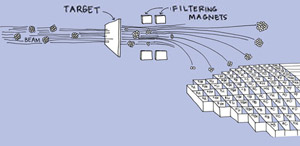

Thursday - April 23, 2009
SLAC Today is
available online at:
http://today.slac.stanford.edu
In this issue:
Probing the Heart of the Atom
Stanford Scholars Named to the American Academy of Arts and Sciences
In the News: World's Most Powerful X-ray Machine Debuts at SLAC
 |
 |
|
Thursday - April 23, 2009 |
Probing the Heart of the Atom Atomic nuclei come in many varieties, called isotopes. They are labeled according to the number of protons and neutrons inside each nucleus. To create isotopes, scientists smash a beam of nuclei into a thin metal target, which leads to a spray of new particles. Magnets filter the beam and separate the sought-after isotopes from the rest of the nuclear chaff.
(Image: Sandbox Studios.)
The familiar elements of the Periodic Table come in a number of forms, or isotopes—some found only fleetingly in the most violent events, such as exploding stars. By creating those rare isotopes in the lab, physicists are learning how the atomic nucleus works and deciphering the natural history of the elements. Andreas Stolz has a problem. Because of advances in superconducting magnet technology, the Michigan State University assistant professor desperately needs a new metaphor to describe the process he and his international collaborators use to create and isolate exotic nuclei. Stolz is a physicist at MSU's National Superconducting Cyclotron Laboratory, or NSCL, one of a handful of facilities worldwide that produce rare isotopes using fast-beam fragmentation. Here's how it works: Scientists accelerate a beam of stable, ionized nuclei to nearly half the speed of light and slam it into a thin metal target. The resulting spray of reaction products continues down the beamline, where a network of magnets separates a few sought-after rare isotopes from the rest of the nuclear chaff. This cutting-edge technology helps scientists probe deeper than ever before into the origins and properties of the atom's core. It's the increasing precision of the filtering magnets that's giving Stolz some grief as he attempts to explain his work. "I used to compare the filtering done by the magnets to finding one person out of all the several billion people on Earth," says Stolz, who has worked as an experimental physicist since the mid 1990s. "Now it would be more like finding one person on a billion Earths, a scenario that's nearly impossible to imagine." Read more in Symmetry magazine... Stanford Scholars Named to the American Academy of Arts and SciencesThe American Academy of Arts and Sciences, one of the country's oldest honorary learned societies, announced Monday the election of 210 new fellows, including 11 Stanford faculty members and a consulting professor. With the election of this year's class, the number of living AAAS fellows in the Stanford community is 254. The newly elected fellows from Stanford include three researchers working in physics. Honoree Aharon Kapitulnik is professor of physics and applied physics and affiliated with the Stanford Institute for Materials and Energy Science at SLAC. His research attempts to learn whether gravity at short distances deviates from Newton's laws, potential evidence for either compact extra dimensions or subatomic particles as yet unseen. Also honored are Professor Hongjie Dai, who performs research into carbon nanotubes and graphene with applications in medicine, electronics and more; and Stuart Parkin, consulting professor of applied physics and director of the IBM-Stanford Spintronic Science and Applications Center. Read more in the Stanford Report. In the News: World's Most Powerful X-ray Machine Debuts at SLAC Looking east, downstream, inside the Undulator Hall, before installation of the undulator magnets.
(Photo by Brad Plummer.)
After years of design and construction, the world's brightest X-ray machine has come to life at the SLAC National Accelerator Laboratory in the hills near Stanford University. The mile-long machine produces a laser beam made of X-rays instead of visible light. Its laser bursts are so bright and so brief that researchers will use them as an ultrafast stop-motion camera to capture the minute details of things previously unseen, such as the arrangement of atoms in metals, semiconductors, ceramics, polymers and proteins. "So you can look at a process like photosynthesis one molecule, one step at a time," said SLAC Director Persis Drell. The laser is expected to have wide-ranging impacts on medicine, advanced energy research and other fields. "This is far and away the brightest X-ray source ever built," said John Galayda, SLAC's director of construction for the laser, which produced its first light last week Read more in the Stanford Report... |
Events (see all | submit)
Access (see all)Announcements
|
|
| | ||
|
|
||
 <%
Response.AddHeader "Last-modified", getArticleDate()
'Response.AddHeader "Last-modified","Mon, 01 Sep 1997 01:03:33 GMT"
'Monday, December 06, 2010
%>
<%
Response.AddHeader "Last-modified", getArticleDate()
'Response.AddHeader "Last-modified","Mon, 01 Sep 1997 01:03:33 GMT"
'Monday, December 06, 2010
%>View online at http://today.slac.stanford.edu/. |
||